Open-aperture TTL metering was pretty standard when I started using 35mm SLRs in the Eighties, but back in the Sixties it was a Big New Thing. These two cameras, the Topcon RE Super and Miranda Sensorex, were pioneers of the genre.
Their specifications are very similar, so they’re worthy of comparison. The key to that is the interchangeable viewfinders – which remained a rare feature and is unheard-of on DSLRs. Apart from that they both have an instant-return mirror, front-mounted shutter release, shutter speeds from 1s to 1/1000s, and a self-timer.
Topcon RE Super
The first to market was the Topcon in 1963. This is a big, square-cornered camera, and oozes quality. The feel of the wind-on action is the most exquisitely smooth I’ve experienced on any SLR. No wonder it was the camera of choice for the US Navy, who ordered special editions by the thousand.
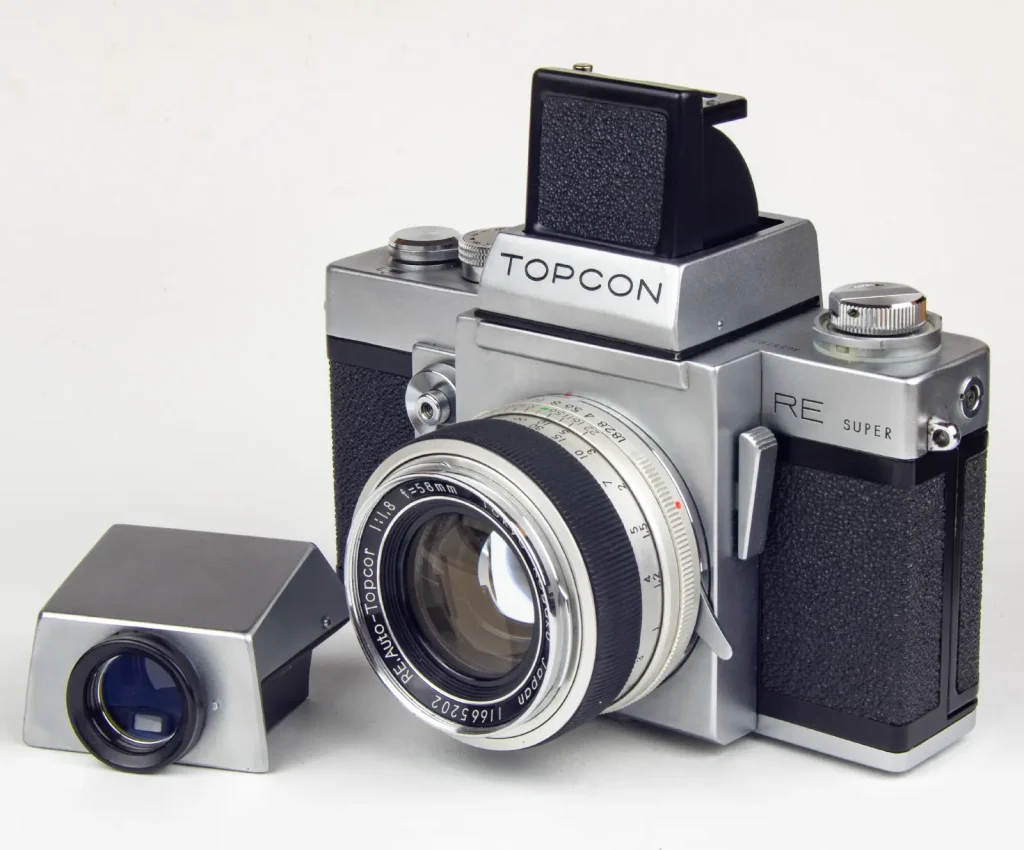
The killer feature of TTL metering was achieved by placing a CdS photocell behind the mirror. A criss-cross pattern of lines cut into the silvering allowed just enough light through to the cell, while remaining unnoticeable in the viewfinder. The meter needle is a swinging T-bar, moving across a circular target. It’s directly visible through a window in the top plate.
Looking into the eye-level pentaprism viewfinder, you realise that the same T-bar needle is visible below the image. Eh? How can that work? The answer can be found in a complicated series of prisms in the finder that look sideways, through a little window into the left side of the top plate. From there, the light is bounced through even more prisms that enable you to see the meter from underneath. Clever.
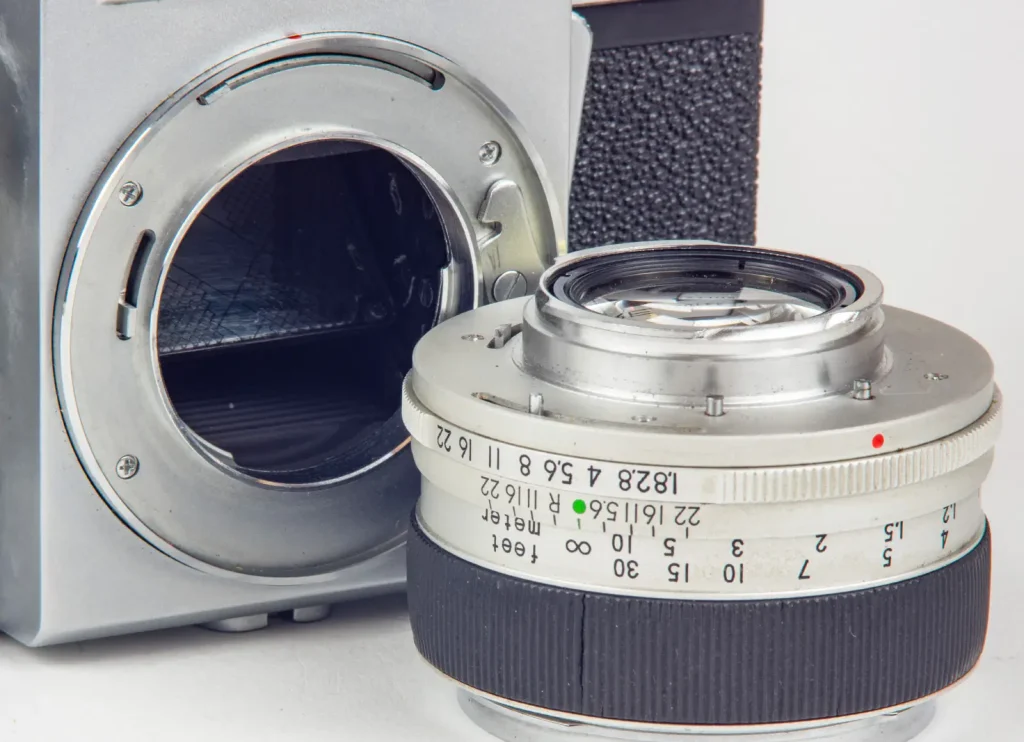
The Topcon uses an enhanced version of the Exakta bayonet mount. It has a small diameter, so the additional mechanical connections that enable open-aperture metering are outside the bayonet and aren’t covered by the lens cap.
Miranda Sensorex
Launched three years after the Topcon, this is a more rounded and stylish design, perhaps making it more consumer-friendly. Again, the TTL photocell is behind the mirror – but this time it sees the world through an oval of horizontal slits. The match-needle meter is above the focusing screen, but to use it you first have to dial in the maximum aperture of the lens on a knob on the left front plate. After that you’re chasing the big orange meter needle with a circle-on-a-stick controlled by the shutter / aperture combination. All very familiar.
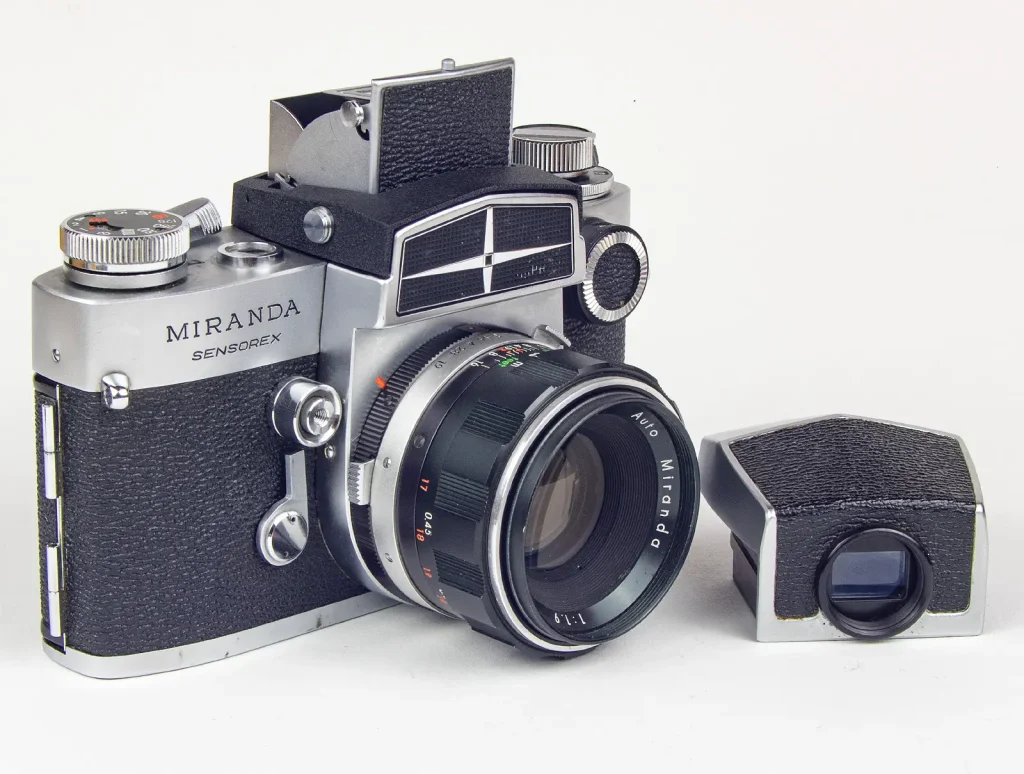
The lens mount is an external bayonet, a bit like the Canon FD design. Despite a decent size and four lugs, it never really feels secure and lenses can rattle around a bit. The aperture coupling is very external — both the body and the lens have a long arm sprouting out, with sprung pin at the end to snap them together.
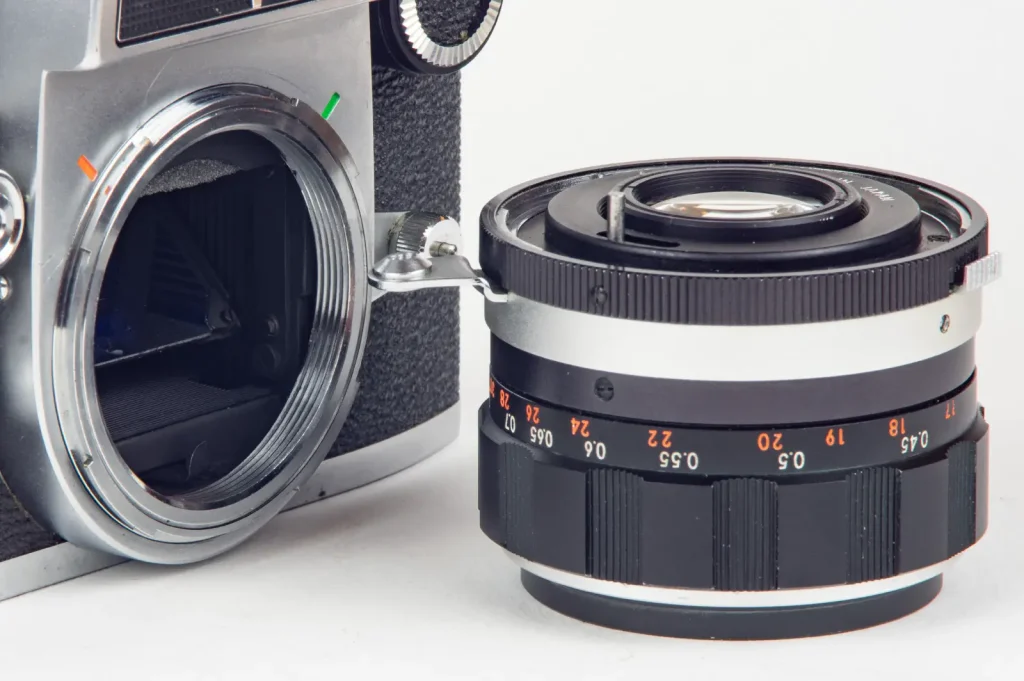
This is a dual mount though, because inside the bayonet is Miranda’s proprietary M44 screw thread. There are no control couplings, so it’s for pre-set lenses only (if you can find any).
Batteries
Both cameras were designed to take the now-discontinued PX625 1.35V mercury oxide battery. There are various workarounds available, and my preferred option is to solder a BAT43 Schottky diode into the wire from the battery compartment. It conveniently absorbs 0.20V, allowing you to use a 1.55V silver oxide SR44. There’s plenty of space for the diode inside both cameras. Job done.
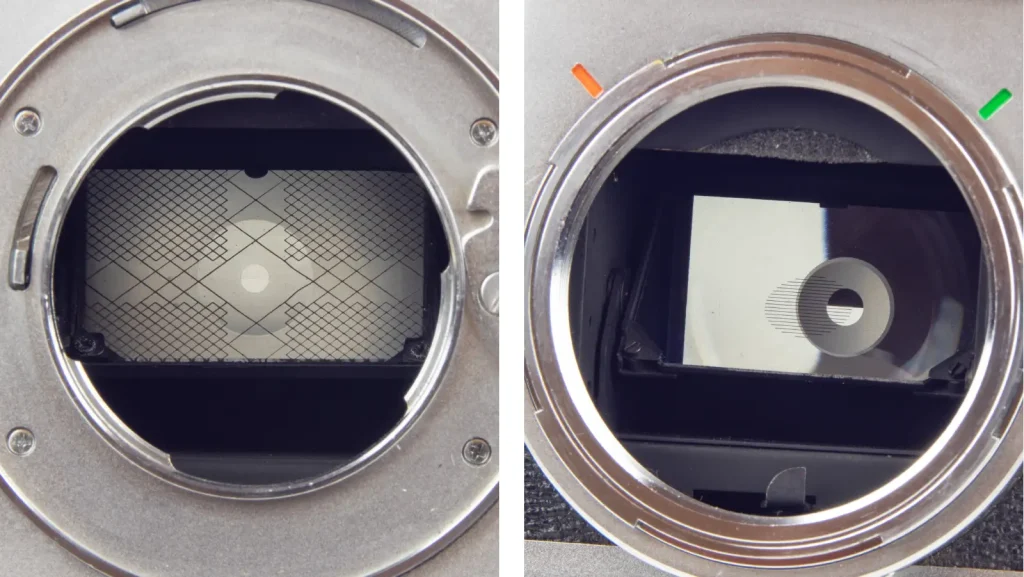
Comparison
As with a lot of consumer choices, it’s the little things that make all the difference. Here’s a run-down of the main three things that impress / annoy me:
Focusing aids
Original equipment is split-image on the Topcon, and microprism spot on the Miranda. Personally I can’t stand microprism focusing and for me it’s a complete deal-breaker. That doesn’t put the Miranda out of contention for anyone who’s handy with a screwdriver. The great access provided by the interchangeable viewfinders means it’s a relatively simple job to swap out the focusing screen for a different one. I chose a nice ‘period’ split-image screen salvaged from a Ricoh 35 Flex, calibrated with shims so it matches the focus at the film plane.
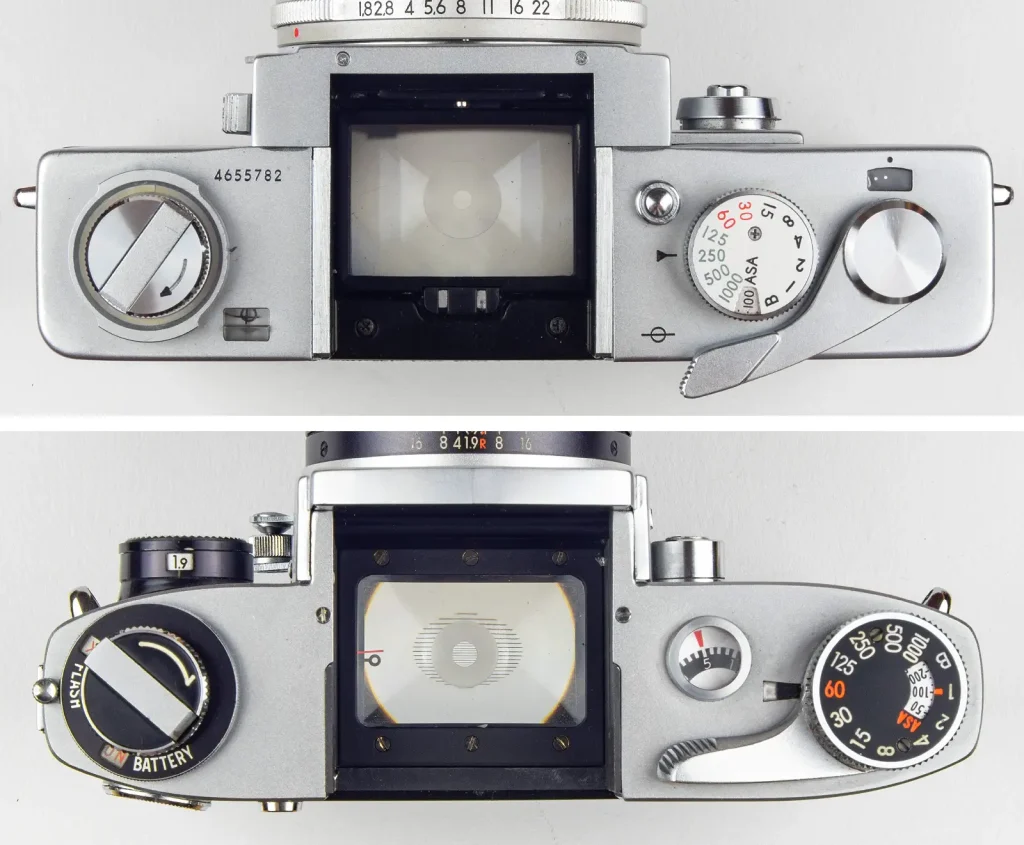
Meter on/off switch
On the Miranda, this is very sensibly placed around the rewind knob and can be quickly operated by your left thumb. The Topcon is a bit of a pain in this respect. The meter switch is recessed into the base plate, and is a bit fiddly. I keep forgetting to switch it off.
Waist-level metering
An optional waist-level finder is available for both cameras, and in both cases takes mere seconds to fit. It’s really just a hinged cover for the bare focusing screen, plus a fold-out magnifier so you can put your eye right up (down?) to it and focus accurately.
There’s an issue with metering though. A TTL meter is affected by light coming in through the viewfinder, which doesn’t matter for eye-level pentaprism finders because your head blocks out the light. With waist-level finders, you can’t block the light as effectively, even when using the magnifier.
Here’s where we can really differentiate these two SLRs. With the Miranda, waist-level metering is always going to be miles off. Perhaps only a stop with the magnifier, but a good 2 or 3 stops without it. The Topcon has an ace up its sleeve. Just close the waist-level finder, and you can still see the meter needle through the window in the top plate. Meter, open the finder, focus, compose, and shoot. Brilliant.
Verdict
I love the looks of the Miranda, but the angularity of the Topcon makes it just as much of a head-turner. As a camera to take out and use, I’d go for the Topcon. Being able to use the meter with the waist-level finder fitted is a wonderful bit of well-thought-out design. Just remember to take a spare battery for when you forget to switch off the meter.
Oh – and good luck finding rear lens caps for either of them. Thanks for reading.
Find me on Instagram here
Share this post:
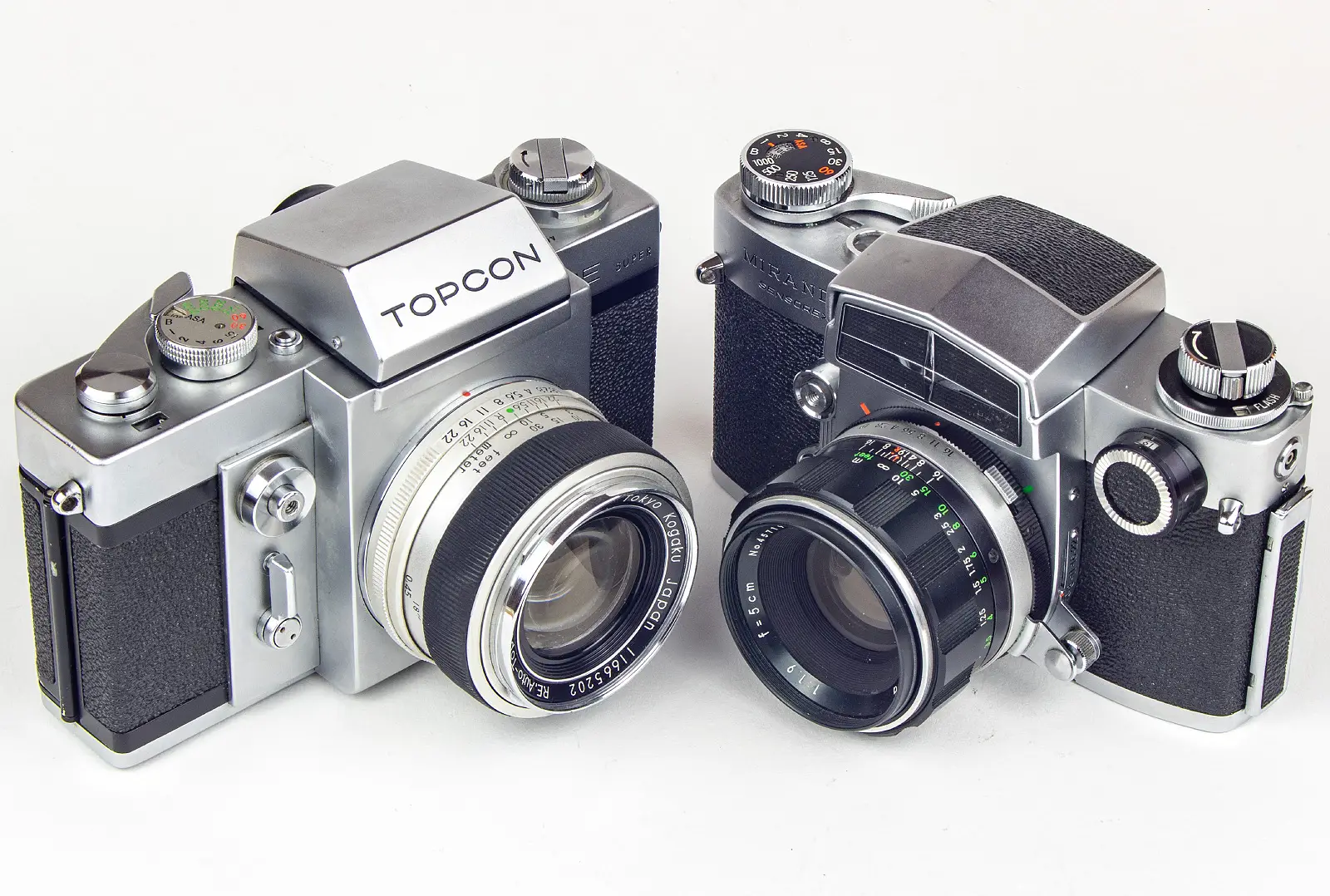








Comments
John Furlong on Topcon RE Super vs. Miranda Sensorex – By Stuart Jenkins
Comment posted: 13/09/2019
If you're still looking for rear lens caps for the Topcon lenses, then have a look at eBay for item #153438778099 I got a couple of them recently and it looks as though they still have some available.
Stuart Jenkins on Topcon RE Super vs. Miranda Sensorex – By Stuart Jenkins
Comment posted: 13/09/2019
I can't get a result on that item number, but I've recently seen some very nice Tamron lens caps for Exacta mount. Very expensive though.
Comment posted: 13/09/2019
Comment posted: 13/09/2019
Nigel Cliff on Topcon RE Super vs. Miranda Sensorex – By Stuart Jenkins
Comment posted: 13/09/2019
Bernhard on Topcon RE Super vs. Miranda Sensorex – By Stuart Jenkins
Comment posted: 13/09/2019
Thank you for presenting this old vintage cameras.
Regards Bernhard
Comment posted: 13/09/2019
Terry B on Topcon RE Super vs. Miranda Sensorex – By Stuart Jenkins
Comment posted: 13/09/2019
I love the looks of it, and always have since I read the press reviews when it first hit the market at a price way, way far too much for me at the time.
Despite my eclectic collection, it's taken me quite a while to get round to considering one. I'm still undecided as with all things film related at the moment prices are going up and to add to my indecision is the situation re lenses. Unlike Nikon, who kept the F mount, Topcon played around with theirs and today it can be quite confusing for someone not familiar with the system to determine which lenses, other than the original ones for the RE Super will fit. Most, if not all, of my Exakta lenses should fit, but it's not the same.
I do have two Miranda cameras, the Sensorex and EE. The meter is dickie in one, and dead in the other, but both are in lovely cosmetic condition and fully working, mechanically. It is well known that Miranda did not make its own lenses but sourced them from a number of lens manufacturers, some good some not so good. And this was the problem I found as I'm not really happy with the Miranda badged standard lenses on either camera I have. But as I got the cameras out of interest more than anything else, and cheaply, and not as shooters, it really isn't an issue. But I mention it as it segues into my observation regarding the lenses. The early Topcon lenses have an enviable reputation for quality and this is where, IMO, the RE Super and its early derivatives will trounce the Miranda. And this will explain the price differential between the cameras and which can't be explained away by build quality as the two Miranda cameras I have aren't poorly built at all.
I also suspect Miranda's odd choice of lens mount was more of an issue than with Topcon's. Why provide a screw variant, but make it 44mm, when the 42mm mount was already well established? They tried to get round this by providing a 44mm to 42mm screw adapter (one of my Miranda bodies fortunately came with one) but why go down this route? Today, I suspect most of these adapters will have been lost, but even if you come across one blindly, how would you know what it was for?
My choice: the Topcon for looks and lens performance, but you'll pay for it! However, if you can find the 42mm screw adapter and which opens up the world of 42mm mount lenses, then the significant price difference could swing it the other way.
Comment posted: 13/09/2019
Dan Castelli on Topcon RE Super vs. Miranda Sensorex – By Stuart Jenkins
Comment posted: 13/09/2019
The US Navy used the Beseler Topcon Super D as their official 35mm camera. It was said at the time that they got the contract because the Navy thought it was an American made camera. I used to deliver some to a local naval base from our store. We were allowed to check out equipment from the store. I always thought the Topcon was superior to the Nikon both optically and mechanically. Topcon suffered from poor management & marketing, and lost the race to Nikon.
The Miranda was an 'engineers' camera. We sold many to construction, engineering and architectural companies. The engineers loved the design and the advanced features. The mount the Miranda (and Canon) used was called a 'breech' mount. An engineer once explained to me it was patterned after the breech loading feature of artillery guns. The thinking was you could always sung up the ring to compensate from lens mount to camera body wear and it wouldn't unscrew like the LTM or the M42 mounts on older Leica and Pentax cameras.
A well written article and I'm glad to see these fine cameras are still producing. Thanks!
Comment posted: 13/09/2019
Comment posted: 13/09/2019
Comment posted: 13/09/2019
Nigel Haycock on Topcon RE Super vs. Miranda Sensorex – By Stuart Jenkins
Comment posted: 13/09/2019
I've not had an issue with the lens feeling loose that I am aware of (Now I'll have to go home and give it a wiggle). My solution for replacement batteries (before I had mine adjusted) was AZ130P hearing aid batteries; they are small but I put a plastic ring around mine to keep them in place. They didn't last a huge amount of time but worked well.
One thing missing from your review is the images; I am sure they both produce great photos but it would be nice to see what yours can do?
Comment posted: 13/09/2019
Comment posted: 13/09/2019
Rob B on Topcon RE Super vs. Miranda Sensorex – By Stuart Jenkins
Comment posted: 13/09/2019
I totally agree with you on the microprism focusing screens - definitely not my favorite which I why I sold my Pentax K1000 and bought a K1000 SE. I'm not a waist level shooter (except when I use my Rolleicord), but it's nice that you pointed out the Miranda's exposure issue with the WLF. I like your focusing screen hack though!
Comment posted: 13/09/2019
James s on Topcon RE Super vs. Miranda Sensorex – By Stuart Jenkins
Comment posted: 14/09/2019
Hello from NZ.
I came here became I've just got a new Topcon GT Total Station for Survey work. We still have the previous two instruments both sokki dating back 25years I guess. I wasn't aware topcon did cameras. Very interesting article I can see many similarities between cameras and survey instruments. BTW I like Leica instruments best.
Comment posted: 14/09/2019
Comment posted: 14/09/2019
Roger B on Topcon RE Super vs. Miranda Sensorex – By Stuart Jenkins
Comment posted: 15/09/2019
Leo Tam on Topcon RE Super vs. Miranda Sensorex – By Stuart Jenkins
Comment posted: 18/09/2019
Dan Stevenson on Topcon RE Super vs. Miranda Sensorex – By Stuart Jenkins
Comment posted: 21/09/2019
Stefan Lindberg on Topcon RE Super vs. Miranda Sensorex – By Stuart Jenkins
Comment posted: 30/12/2019
Comment posted: 30/12/2019
Comment posted: 30/12/2019
Comment posted: 30/12/2019
Malcolm Brenner on Topcon RE Super vs. Miranda Sensorex – By Stuart Jenkins
Comment posted: 01/07/2023
Needless to say, Consumer Reports lost a lot of photographic subscribers after that debacle.
A year or so later, Popular Photography, a profit-driven magazine that accepted advertising from anybody legal, did a strip-down evaluation on the Sensorex, part by part. Many parts that could have been made of steel were found to be made of brass, and this PARTICULAR camera body was the ONLY one I saw, in years of reading PopPhoto's independent tests, that didn't earn a GOOD rating for "Construction and Materials." It earned a FAIR! The ONLY ONE, not Petri, Yashica, Praktica, or any of the other B-grade cameras on the market. Draw your own conclusions!
(Me? Shooting with a Fujica V2 rangefinder. Hey, it had a great lens!)
Comment posted: 01/07/2023